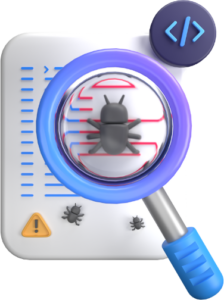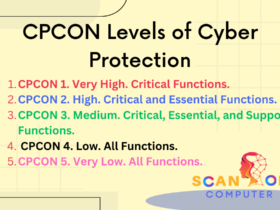Website Malware Removal (WordPress & PHP)
Free Website Malware Scanner is an invaluable tool that enables you to inspect the front-end of your site for signs of malware, as well as external links, iframes, referenced domains and infected files.

What Our Free Malware Removal Code Do?
As soon as your website is compromised, make sure that it has a backup. This will prevent having to rebuild it from scratch later.
Upload our Removal code in to the server to look out for common hacking syntax such as: eval, base64_decode, fromCharCode, gzinflate and shell_exec.
Website Block List
Checking
The website becomes obsolete if it is infected with malware and added to the list of ‘blacklisted’ website.
Phishing
Attack
Phishing is a sort of online scam to collect information such as user account credentials, bank details, and more
Back Door
Backdoors are critical because they allow access to admin even after the vulnerability is fixed that led to the hacking of the website.
Trojan Virus
A Trojan has very peculiar characteristics, it masks itself as a genuine file, but the content in it is always malicious with the intention to steal data and other confidential files.
Suspicious Code
Suspicious code is code that will add as malware practices to your existing source code & It can be found in your website templates, themes, plugins, & also in database.
Malware Download
Malware is (potentially) well-written software, indistinguishable from any other piece of code until it performs a malicious act.
Malware detection Techniques
Recognizing malware on a website is key to its removal. If your site seems slower than normal, its appearance has changed or search engines flag it, it may have an infection. If this is suspected, then using a malware scanner such as Sucuri is the best way to identify infected files and remove them – this scanner can identify many different forms of infections including backdoor files and shell scripts.
Infections can happen in various ways, but one common route is through vulnerabilities in your website’s source code. Cybercriminals exploit these flaws to gain entry and host malicious software on your server. To defend against these attacks, make sure that your website’s code is always up to date and patched promptly as new versions become available; also only utilize plugins and features necessary for your business.
Another method for checking for malware on websites is using VirusTotal’s free online tool to analyze it against over 60 trusted threat databases for signs of viruses and malware.
Once you’ve identified infected files on your website, it’s vital that they are removed promptly and permanently from it. To accomplish this, a malware scanner, backup of your website, and knowledge of your content management system (CMS). Drupal, WordPress or Joomla users may prefer using their CMS file manager; other options include command line tools or FTP clients as effective methods.
Once the infected files have been deleted from your website, rescanning it with a malware scanner and restoring a clean backup are key steps in protecting yourself against further damage from malware. It’s especially crucial that this be done as soon as possible because the longer malware stays in, the more damage it can do – not to mention Google flagging it and warning visitors accordingly, which could have an enormously detrimental effect on business revenue loss.
Malware removal
Malware removal is an integral step for website owners looking to protect their sites and the personal data of visitors. There are various signs that a site has been infiltrated with malware, including changes in login details or missing or modified files; pages which freeze up or crash; an overall decrease in site traffic; flagged as unsafe by search engines – or worse still be removed altogether from search listings altogether!
To check whether or not your website has been infected by malware, run a free web scanner like Virus Total, Sucuri, Hosted Scan Security, Upguard or Observatory. These will scan the entire site to search for suspicious code that might exist and identify any infected files and folders – however this will not provide a comprehensive solution as this doesn’t remove malware or address vulnerabilities that led to its creation in the first place.
Another method for identifying infected files is using a file manager and manually inspecting each file. Malware often comprises longer texts within files than their normal contents, making them easy to spot with such tools. Furthermore, most file managers provide color coding of syntax for easier identification of suspicious code.
When dealing with infected files, it’s essential that a backup of your website be made before beginning the removal process. This allows you to easily restore it should any issues arise during cleanup. Also be sure to review your hosting provider’s malware removal policy prior to restoring your site – some hosts offer emergency website restoration, blacklist removal and other security services through premium plans only.
As part of your website security plan, it is also crucial that software and plugins remain up-to-date, strong passwords are utilized and two-factor authentication enabled – these simple steps can dramatically strengthen its protection and prevent any future malware infections from appearing on your website. Furthermore, regularly monitor for potential security threats on the web as well as train employees on best security practices.
Malware prevention
Malware, or Malicious Software, enables cybercriminals to gain unauthorized access and damage computers and websites without their owners’ knowledge and consent. Malware infections may lead to intellectual property theft, customer loss, financial fraud and destruction of property; for businesses this could have grave repercussions for reputation and credibility – however fortunately there are tools and services available that can assist in protecting a website against infection – these range from malware scanners and defacement detection tools through to website defacement detection and removal services.
Not only should companies monitor for malware on their website, it is also crucial to take note of its overall health. For instance, if a site loads slowly or displays error messages frequently it could be infected with bots, adware or other types of malware. Sending spam or showing popup windows could also indicate an infection on the site.
To determine whether or not a website is infected, it’s wise to seek professional help or utilize tools like Sucuri or SiteLock. These tools can detect malware quickly and remove it quickly depending on the plan you select, while simultaneously protecting against future attacks by detecting vulnerabilities that exist and immediately eliminating them.
If your company website has become infected, the first step should be to backup. This will protect files that could otherwise be lost during the malware removal process. Once done, identify infected files and delete them before performing a malware scan regularly – this way, any suspicious code will be quickly identified and eliminated before having an impactful impact.
Once malware has been eliminated from your website, restoring from backup can help. Unfortunately, it will still contain vulnerabilities which allowed it to become infected in the first place; to reduce future attacks of this nature it would be prudent to install a vulnerability scanner as a preventative measure and only install plug-ins from trusted sources.
Malware cleanup
Malware infections on websites can have devastating repercussions for performance and user experience, as well as invading browsers’ files with malware files that alter them or steal cookies from visitors. To address the situation, the first step should be identifying whether your website has been infiltrated; free online virus scanners and SEO checkers provide this service; they will look for malicious code which infiltrates websites to redirect visitors to fraudulent sales sites or to collect cookies. Once identified, malware removal tools should be utilized to delete the files containing malicious files from your website’s files – once detected they will help remove them completely from your website’s files and databases.
Malware detection on websites can be challenging if you don’t know how to spot it, especially since most hacks contain multiple files that must be removed. To quickly check if your website is infected with malware, run it through an online virus scanner such as Virus Total, Sucuri, Hosted Scan Security Upguard Observatory. After running through these scanners you can compare files against each other in order to identify those which shouldn’t be there and remove any that don’t belong there.
If you suspect your website has been infiltrated with malware, be sure to back up all files on the server prior to starting any cleaning process. That way, should anything go amiss during cleaning procedures, you can restore them as before. Also ensure you install WordPress from scratch to avoid reinfection of old installations.
Once your website has been cleaned up, it’s essential to get it off Google’s blacklist. To do this, use Search Console which takes up to several days or hire professional services like Fixed who offer website cleanup for one-time fees.
Hostinger provides an in-built malware scanner to check for suspicious files on your site, scanning content, files and iframes for signs of unauthoritiized code and then detect and clean infected files – without interrupting user experience – before uploading back up onto host server without disrupting user experience. In addition to providing comprehensive analysis, Hostinger adds a malware indicator directly into their dashboard so you can keep an eye on how your website is progressing at a glance.




